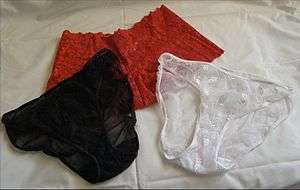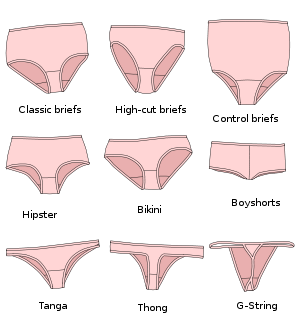Panties
Panties (in American English, also called pants, undies or knickers in British English) are a form of underwear primarily worn by women. Panties can be form-fitting or loose. Typical components include an elastic waistband, a crotch panel to cover the genitalia (usually lined with absorbent material such as cotton), and a pair of leg openings that, like the waistband, are often made of elastic. Various materials are used, but are usually chosen to be breathable.

Terminology
In the United Kingdom, Ireland, South Africa, Malaysia, Singapore and occasionally in other Commonwealth countries such as Australia[1][2] and New Zealand, panties may be referred to as "undies" or "knickers"; "knickers" can also refer to male underwear, while "panties" generally refers only to female underwear. In Australia, men's underpants are often referred to as "undies",[3] although the word can also refer to women's underpants. In the UK, the term "pants" is also used for both men's and women's underwear (not to be confused with the North American usage of "pants", referring to what both Americans and the British call "trousers" – although "pants" is also used in some parts of Northern England). Both men's and women's underpants are also sometimes referred to as "drawers".
Styles

Panties are classified into various styles based on criteria such as the amount of rear coverage, width at the sides and height at which they are worn. These categories are not necessarily distinct and usage may vary somewhat among brands:[4]
- Adhesive panties are sometimes described as strapless/stick-on panties. They are a form of micro-panties that cover the bare minimum parts on the front and back. They are useful when women do not want the panty line to be visible.
- Bikinis, like hipsters, sit at hip level, but the fabric of the side sections is narrower. With the string bikini type, the side sections disappear altogether and the waistband consists of only string-like material. There may be less rear coverage with the bikini style.
- Boyshorts are styled after men's boxer briefs and have short legs extending below the crotch.
- Briefs rise to the waist, or just below the navel, and have full coverage in the rear.
- Classic briefs, sometimes called "granny panties" because they were the standard underwear of the early to mid 1900s and they look like a style for older ladies. The waistband sits very high on the waist. The leg holes are small so the underwear cover as much area between waist and thigh as possible. They can only be properly worn with high waisted clothing, which was usual when these underwear were common.
- Control briefs are designed to offer support while giving a slimmer appearance. This type usually contains a stretch material such as spandex and may extend above the waist. Some have an extra firm panel to flatten the tummy. Some also compress the buttocks, while other control briefs are designed to avoid compression of the buttocks. Some just lift the buttocks and have holes cut out for maximum fullness of the buttocks.
- High-cut briefs are designed with larger leg holes and narrower sides to show off more leg and allow more freedom of movement.
- Hipsters are worn lower down on the body, with the waistband straight across the hips.
- Tangas provide a moderate to minimal coverage with back coverage that is less than a bikini, and the waistband is reduced to a narrow strip at the sides.[5]
- The G-string has a vertical string at the back, which connects the crotch to the waistband, sometimes featuring a triangle of fabric which is the part that is sometimes referred to as a whaletale when it peeks out above the waistband of low riding pants. Basically a less covering thong.
- The T-front is a type of G-string in which the string reaches also the front part. It provides almost no coverage while still maintaining the basic hygienic underwear functions and covering only the genitalia. Usually it is built by strings only, sometimes with more fabric or lace around the waist.
- Thongs have a waistband similar to tangas, but the rear coverage is mostly cut away. The crotch is triangle shaped as it narrows to a thin strip toward the back and sits between the buttocks, becoming wider towards the top where it connects to the waistband. The term thong is American, in Britain and Australia if you ask for a thong you'll get a flip-flop sandal. They call thong undies a g-string.
Cheekies can be styled as a hipster, bikini, or boyshort in the front, but in the back it's designed to hug the butt cheeks and have a seam or runching to make the fabric sit partially between the cheeks to accentuate the shape. It leaves the outer 1/3 to 1/2 of each cheek exposed and often have a lace or scalloped trim. Panties are made of a variety of materials, including cotton, lace, latex, leather, lycra, mesh, nylon, PVC, polyester, rawhide, satin, and silk. Construction typically consists of two pieces (front and rear) that are joined by seams at the crotch and sides; an additional gusset is often in the crotch, with the waistband and leg-openings made from elastic.
Boyshorts
_(cropped).jpg)
Boy shorts or boyshorts, also known as boy short panties, boys' cut, booty shorts, shorties, or boyleg briefs are a kind of women's underwear that covers the hips, named for their similarity to boxer briefs, a variation on boxer shorts. Some resemble men's briefs, complete with fly and contrast trim. Unlike men's briefs, this style is usually lower cut. Boy shorts often cover most of the buttocks.[6][7]
Boyshorts have become a popular choice, since they avoid displaying a prominent visible panty line, and are a modest and comfortable alternative to thongs and conventional panties. They are also popularly matched with a camisole top and worn as loungewear. Cotton-spandex blends and lace are the most popular materials for boyshorts. The term boyshorts can also refer to bathing suit bottoms in the same style.[6]
History
The earliest known use of underwear that resembles modern panties dates back to 4,400 B.C. during the Badari period in Egypt.[8]
See also
References
- Burgdorf, Katherine (12 November 2013). "Say 'NO' to dodgy knickers". The Hoopla. Archived from the original on 2 April 2014. Retrieved 22 March 2018.
- "Hole Proof - No Knickers". Bonds underwear, Australia. 1985. Archived from the original on 3 June 2014. Retrieved 16 December 2014.
- "Translations of Australian English words into American English - Fiona Lake". Archived from the original on 24 March 2015. Retrieved 23 March 2015.
- Parkinson, Ann (9 September 2011). "Women's Panties - LoveToKnow Lingerie". Lingerie.lovetoknow.com. Archived from the original on 29 August 2011. Retrieved 13 September 2011.
- Jennifer Carroll; Kathy Schultz (1 October 2009), Underneath It All, Harlequin, p. 41, ISBN 978-1-4268-4072-2, retrieved 14 September 2013
- "Boy shorts" Archived 19 November 2015 at the Wayback Machine, Oxforddictionaries.com, 2015.
- "Boyshorts and Girltrunks 102: Your Queer Underwear Guide" Archived 1 October 2017 at the Wayback Machine, Autostraddle.com, 05-03-2013.
- Brunton, Guy; Caton-Thompson, Gertrude (1928). The Badarian Civilisation and Predynastic Remains Near Badari (PDF). British School of archaeology in Egypt, University College, and B. Quaritch. Archived (PDF) from the original on 19 August 2014. Retrieved 6 August 2014.
Havolalar
| Wikimedia Commons has media related to Women's knickers. |
- Nomani, Asra Q. (8 June 1999). "How Thong Underwear Managed to Win Over a Mainstream Market". The Wall Street Journal. Retrieved 22 March 2018.